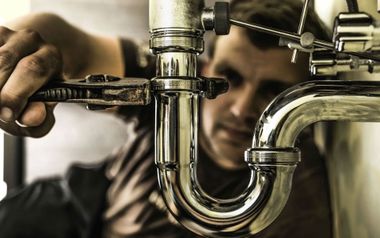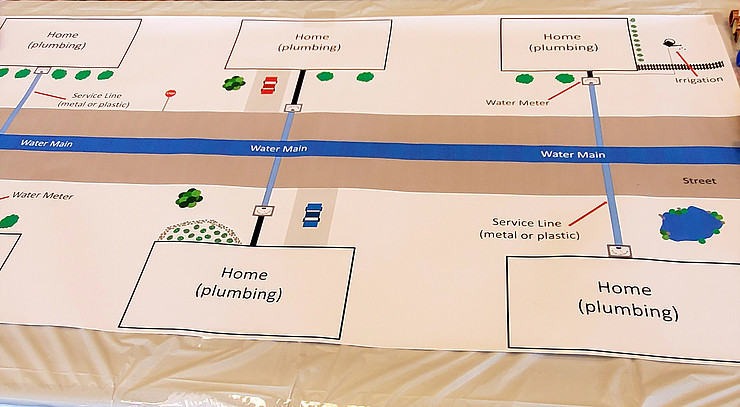Everything You Need to Know to Your Home's Plumbing System Anatomy
Everything You Need to Know to Your Home's Plumbing System Anatomy
Blog Article
We've unearthed this article relating to The Inner Workings of Your Home's Plumbing below on the net and figured it made good sense to share it with you on my blog.

Comprehending just how your home's plumbing system works is essential for each property owner. From delivering tidy water for drinking, cooking, and showering to safely removing wastewater, a well-kept pipes system is essential for your family members's health and wellness and convenience. In this extensive overview, we'll check out the detailed network that comprises your home's plumbing and offer suggestions on upkeep, upgrades, and handling typical concerns.
Introduction
Your home's pipes system is greater than just a network of pipes; it's an intricate system that ensures you have access to tidy water and reliable wastewater elimination. Understanding its elements and just how they collaborate can aid you avoid pricey repairs and make sure every little thing runs efficiently.
Fundamental Parts of a Pipes System
Pipelines and Tubing
At the heart of your pipes system are the pipelines and tubing that carry water throughout your home. These can be made from numerous materials such as copper, PVC, or PEX, each with its benefits in terms of toughness and cost-effectiveness.
Fixtures: Sinks, Toilets, Showers, etc.
Fixtures like sinks, bathrooms, showers, and bath tubs are where water is used in your home. Comprehending just how these fixtures connect to the plumbing system helps in detecting problems and preparing upgrades.
Valves and Shut-off Factors
Valves manage the circulation of water in your pipes system. Shut-off shutoffs are essential throughout emergency situations or when you need to make repair work, allowing you to isolate parts of the system without interrupting water circulation to the whole residence.
Water Supply System
Main Water Line
The main water line links your home to the metropolitan water or a private well. It's where water enters your home and is dispersed to numerous components.
Water Meter and Stress Regulatory Authority
The water meter measures your water use, while a stress regulatory authority makes certain that water moves at a secure stress throughout your home's pipes system, protecting against damages to pipelines and components.
Cold Water vs. Warm water Lines
Recognizing the difference in between cold water lines, which provide water straight from the primary, and warm water lines, which bring warmed water from the water heater, aids in repairing and preparing for upgrades.
Drain System
Drain Pipes Water Lines and Traps
Drain pipes bring wastewater away from sinks, showers, and toilets to the sewer or septic tank. Catches stop sewer gases from entering your home and also catch particles that can trigger blockages.
Ventilation Pipelines
Air flow pipelines enable air into the water drainage system, preventing suction that could slow down drainage and cause catches to vacant. Appropriate ventilation is important for maintaining the integrity of your pipes system.
Value of Appropriate Drainage
Making certain appropriate drain prevents back-ups and water damage. Frequently cleaning drains and preserving traps can prevent expensive repair work and expand the life of your plumbing system.
Water Heating Unit
Sorts Of Water Heaters
Water heaters can be tankless or typical tank-style. Tankless heaters warm water on demand, while containers keep warmed water for instant usage.
Updating Your Plumbing System
Factors for Upgrading
Upgrading to water-efficient components or replacing old pipelines can improve water high quality, decrease water costs, and enhance the worth of your home.
Modern Plumbing Technologies and Their Advantages
Check out technologies like wise leakage detectors, water-saving bathrooms, and energy-efficient water heaters that can conserve money and lower environmental influence.
Cost Factors To Consider and ROI
Calculate the ahead of time expenses versus lasting financial savings when considering pipes upgrades. Many upgrades spend for themselves through lowered utility expenses and less repair work.
Just How Water Heaters Link to the Pipes System
Understanding exactly how hot water heater link to both the cold water supply and warm water distribution lines aids in identifying problems like insufficient hot water or leakages.
Upkeep Tips for Water Heaters
Routinely purging your water heater to eliminate debris, checking the temperature settings, and evaluating for leaks can prolong its life-span and improve energy effectiveness.
Common Pipes Concerns
Leakages and Their Reasons
Leaks can happen as a result of aging pipelines, loosened fittings, or high water pressure. Resolving leaks quickly stops water damages and mold and mildew development.
Obstructions and Blockages
Blockages in drains pipes and commodes are usually caused by flushing non-flushable products or an accumulation of oil and hair. Making use of drain screens and being mindful of what drops your drains pipes can prevent obstructions.
Indications of Pipes Troubles to Watch For
Low water pressure, sluggish drains pipes, foul odors, or abnormally high water costs are signs of potential plumbing issues that must be attended to without delay.
Pipes Maintenance Tips
Regular Examinations and Checks
Arrange annual plumbing assessments to capture concerns early. Try to find indications of leakages, deterioration, or mineral accumulation in taps and showerheads.
Do It Yourself Upkeep Tasks
Basic jobs like cleansing tap aerators, looking for commode leaks using color tablet computers, or insulating revealed pipelines in cool environments can protect against significant pipes problems.
When to Call an Expert Plumbing Technician
Know when a pipes problem needs professional knowledge. Attempting complicated repair services without appropriate knowledge can bring about even more damages and greater repair service costs.
Tips for Reducing Water Usage
Simple behaviors like dealing with leaks promptly, taking much shorter showers, and running complete loads of washing and recipes can preserve water and reduced your utility bills.
Eco-Friendly Plumbing Options
Take into consideration lasting plumbing products like bamboo for floor covering, which is durable and environment-friendly, or recycled glass for counter tops.
Emergency Preparedness
Steps to Take During a Plumbing Emergency
Know where your shut-off shutoffs lie and how to turn off the water system in case of a burst pipeline or major leakage.
Relevance of Having Emergency Calls Convenient
Keep contact details for regional plumbers or emergency situation services conveniently offered for quick response throughout a plumbing situation.
Ecological Impact and Preservation
Water-Saving Fixtures and Devices
Installing low-flow taps, showerheads, and bathrooms can significantly lower water usage without sacrificing efficiency.
DIY Emergency Situation Fixes (When Appropriate).
Temporary repairs like making use of duct tape to spot a leaking pipeline or placing a pail under a leaking tap can reduce damages until a specialist plumbing shows up.
Final thought.
Recognizing the composition of your home's pipes system empowers you to preserve it effectively, conserving time and money on repair work. By adhering to routine upkeep routines and remaining educated about contemporary pipes innovations, you can guarantee your pipes system operates successfully for years to find.
The Anatomy of Your Home s Plumbing System
Understanding the anatomy of your home s plumbing system is essential for any homeowner. It not only helps in identifying potential issues but also facilitates effective communication with professionals when repairs or upgrades are needed. Your home s plumbing system is more than just pipes and faucets; it s a complex network that ensures the efficient and hygienic flow of water in and out of your house. In this blog, we ll dissect the crucial components of your home s plumbing system. For those in Antelope Valley, Brock Plumbing is your trusted partner for all your plumbing needs, ensuring your system functions smoothly and efficiently.
Water Supply System
Main Water Line: This is where your home s plumbing system begins. The main water line connects your home to the public water supply or a private well. Pipes and Shut-off Valves: Pipes distribute water throughout your home. Shut-off valves are crucial for controlling the flow of water and making repairs without shutting off the entire system. Drainage System
Drain Pipes: These pipes carry waste and water away from sinks, toilets, and showers. Vents: Vents allow sewer gases to escape and help maintain proper pressure in the drainage pipes, ensuring efficient flow of wastewater. Traps: Every fixture has a trap, a U-shaped pipe that holds water and prevents sewer gases from entering your home. The most common is the P-trap under sinks. Fixtures and Appliances
Fixtures and appliances are the most interacted with parts of your plumbing system. They include sinks, toilets, showers, dishwashers, and washing machines. Each fixture and appliance has its own supply and drainage connection, ensuring they receive clean water and can dispose of wastewater effectively.
Water Heating System
Your water heater is a crucial component, providing hot water to various fixtures and appliances in your home. It can be tank-based or tankless, with each type having its own set of advantages and maintenance requirements. Regular maintenance is essential to ensure efficient operation and extend the lifespan of the unit.
Sump Pump
In areas prone to flooding or with high water tables, a sump pump is an essential part of the plumbing system. It s installed in the lowest part of your basement or crawlspace and pumps out water that accumulates, preventing flooding and protecting your home from water damage.
Septic System
Homes that are not connected to a municipal sewer system have a septic system and an underground wastewater treatment structure. Understanding how to maintain your septic system is crucial to prevent backups, odors, and early system failure.
Conclusion
Your home s plumbing system is a complex and essential network, ensuring the efficient and hygienic flow of water in and out of your property. Understanding its key components helps in maintaining it properly and identifying issues before they escalate into major problems. For residents in Antelope Valley, Brock Plumbing is dedicated to providing top-notch services, ensuring that every part of your plumbing system is in perfect working order. Trust our team of professionals to handle all your plumbing needs, ensuring your home remains comfortable, safe, and well-maintained.
https://brockplumbinganddrains.com/blog/the-anatomy-of-your-homes-plumbing-system/

I'm very drawn to Understanding Your Home's Plumbing Anatomy and I hope you enjoyed my blog entry. Are you aware of somebody else who is fascinated about the niche? Be sure promote it. Thanks for being here. Don't hesitate to come visit our website back soon.
Book A Free Estimate Report this page